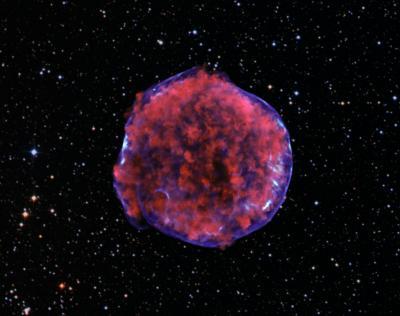When a star goes supernova, it shines brightly for a few weeks or months before fading away. Yet the material blasted outward from the explosion glows hundreds or thousands of years later, leaving a picturesque supernova remnant. But how?
Tycho's supernova was witnessed by astronomer Tycho Brahe in 1572. The appearance of this "new star" stunned those who thought the heavens were constant and unchanging. At its brightest, the supernova rivaled Venus before fading from sight a year later. Modern astronomers know that the event Tycho and others observed was a Type Ia supernova, caused by the explosion of a white dwarf star. The explosion spewed elements like silicon and iron into space at speeds of more than 11 million miles per hour (5,000 km/s).
But Tycho's supernova remnant isn't done providing answers yet. Astronomers have discovered that a reverse shock wave racing inward at Mach 1000 (1000 times the speed of sound) is heating the remnant and causing it to emit X-ray light.

Photograph of the Tycho supernova remnant taken by the Chandra X-ray Observatory. Low-energy X-rays (red) in the image show expanding debris from the supernova explosion and high energy X-rays (blue) show the blast wave, a shell of extremely energetic electrons. Credit: X-ray: NASA/CXC/Rutgers/K. Eriksen et al.; Optical (starry background): DSS
When the ejecta rammed into surrounding interstellar gas, it created a shock wave - the equivalent of a cosmic "sonic boom." That shock wave continues to move outward today at about Mach 300. The interaction also created a violent "backwash" - a reverse shock wave that speeds inward at Mach 1000.
"We wouldn't be able to study ancient supernova remnants without a reverse shock to light them up," says Hiroya Yamaguchi, who conducted this research at the Harvard-Smithsonian Center for Astrophysics (CfA).
"It's like the wave of brake lights that marches up a line of traffic after a fender-bender on a busy highway," explains CfA co-author Randall Smith.
The reverse shock wave heats gases inside the supernova remnant and causes them to fluoresce. The process is similar to what lights household fluorescent bulbs, except that the supernova remnant glows in X-rays rather than visible light. The reverse shock wave is what allows us to see supernova remnants and study them, hundreds of years after the supernova occurred.
"Thanks to the reverse shock, Tycho's supernova keeps on giving," says Smith.
The team studied the X-ray spectrum of Tycho's supernova remnant with the Suzaku spacecraft. They found that electrons crossing the reverse shock wave are rapidly heated by a still-uncertain process. Their observations represent the first clear evidence for such efficient, "collisionless" electron heating at the reverse shock of Tycho's supernova remnant.





Comments